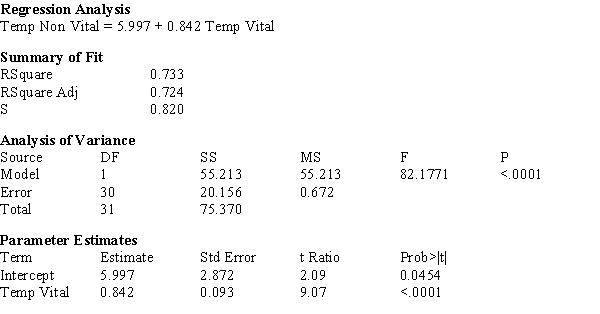Essay
In a study of the surface temperatures of vital (living) and non-vital (dead) teeth in a random sample of 32 adults seeking dental care at a university clinic, temperatures of vital and non-vital teeth were measured for each individual. From their examination of the data the investigators felt that the assumptions of the linear regression model were satisfied. The computer output shown below was generated. 
a) What proportion of observed variation in the surface temperature of non-vital teeth can be explained by the surface temperature of vital teeth?
b) Does the simple linear regression model appear to be useful? Justify your response with specific references to the computer output.
c) The estimated standard deviation of a + bx* for x* = 30 is calculated as: sa+b(30) = 0.1665. Calculate a 95% confidence interval for the true average non-vital tooth temperature when the vital tooth temperature is 30 degrees centigrade.
d) In one individual, a single surface temperature for a vital tooth is found to be 30 degrees centigrade. Use a 95% prediction interval to predict the resulting temperature of a non-vital tooth.
Correct Answer:

Verified
a) r2 = 0.733
b) Yes, since tβ = 9.07 and...View Answer
Unlock this answer now
Get Access to more Verified Answers free of charge
Correct Answer:
Verified
b) Yes, since tβ = 9.07 and...
View Answer
Unlock this answer now
Get Access to more Verified Answers free of charge
Q1: The expected change in the value of
Q2: A standardized residual plot with spread increasing
Q3: The Iowa Tests of Educational Development are
Q4: In a study of the surface temperatures
Q5: In a forensic study of the relation
Q7: The standard deviation of a + bx*
Q8: What are the four "Basic Assumptions" of
Q9: An experiment to study the relationship between
Q10: The population correlation ρ is always between
Q11: The test of independence involves testing H<sub>0</sub>